
It’s your worst nightmare. Blocks that were cut the same size suddenly don’t fit together or line up. That 12 1/2″ bee block you spent ALL afternoon sewing is suddenly only 12 1/8″. The quilting gurus will tell you to double check your seam allowance, and to only use the same ruler for all your cutting. But the culprit might be sitting there right beside your iron!
Do not get me wrong. I love my starch spray. It is a great tool for stabilising fabric, it reduces fraying and helps stop bias edges on triangles from stretching out of shape. It is a valuable part of a quilters arsenal.
But did you know it also SHRINKS your fabric?
I conducted a couple of experiments which demonstrate this little fact, so often overlooked.
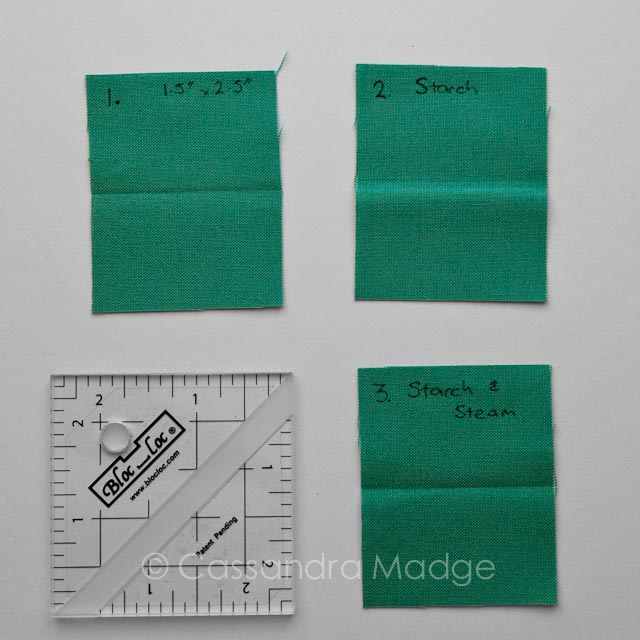
Here are my test rectangles. All of them cut exactly the same size from the same “virgin” fabric which had been lightly pressed for cutting but not pre-washed or previously starched. (Ignore my written width measurement, I was obviously having a dyslexic moment!) You can see the centre crease running across each of them – horizontally we have the lengthwise grain (parallel to the selvedge) and vertically is our crosswise grain (running from selvedge to selvedge).
Noted on each piece was the treatment it was going to be given – a hot iron, hot iron and starch, hot iron, steam and starch.
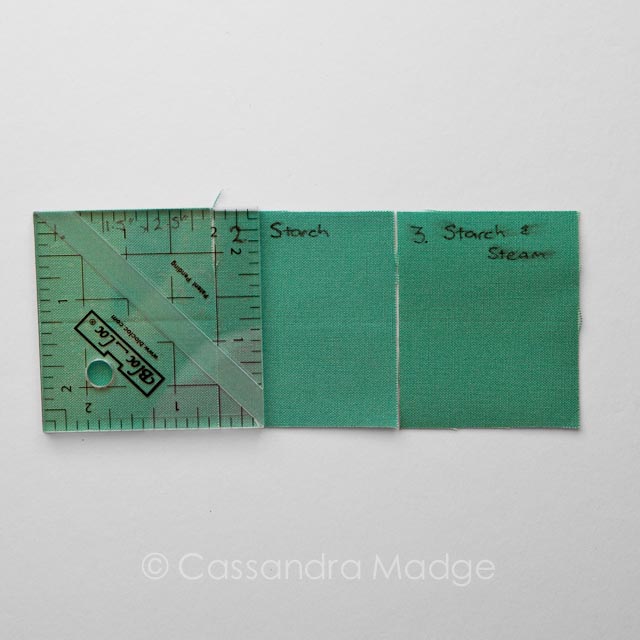
Here are the same three pieces of fabric after pressing, starching and steaming. Whoopee Cassie, all you did was make your pigment pen bleed. Whoops! But let’s look a bit closer shall we?
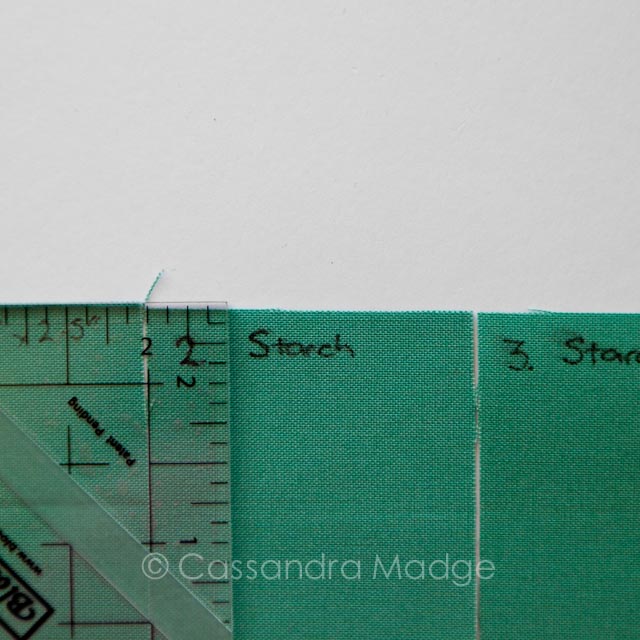
The lengthwise grain is described by Marti Michell as the most stable, and she is right. They didn’t shrink at all in width. However BOTH samples that were starched have shrunk along the crosswise grain. It’s only by a few threads worth, but now imagine this over a much larger sample…. or multiple pieces inside a block.
Ok, but that’s really not a huge difference. Why the big fuss?
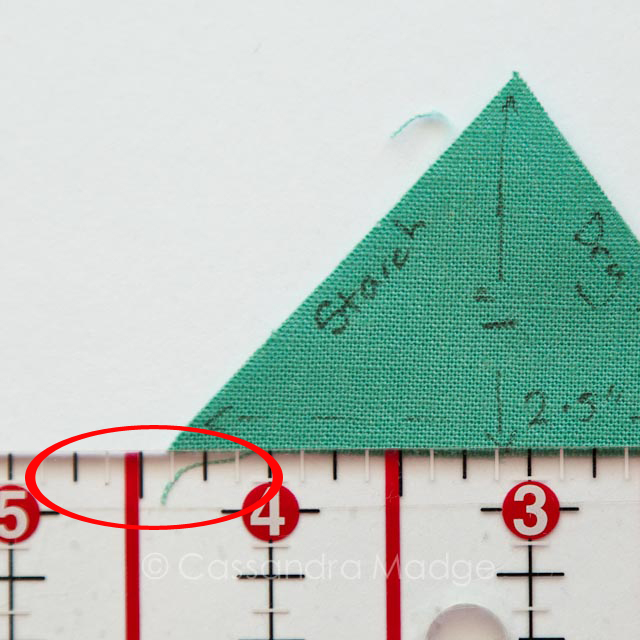
I repeated the same test on this triangle using a hot iron and starch (no steam). It was cut at 2.5″ long. What I have highlighted here is that this triangle, because of the highly unstable bias on two sides, has shrunk a full 1/8″ – one eighth of an inch. That is 5% of the length of this triangle, gone.
Now imagine what this would do across a 12″ block? 5% of 12″ is .6″ – there is your missing seam allowance that you spent all day carefully sewing and pressing.
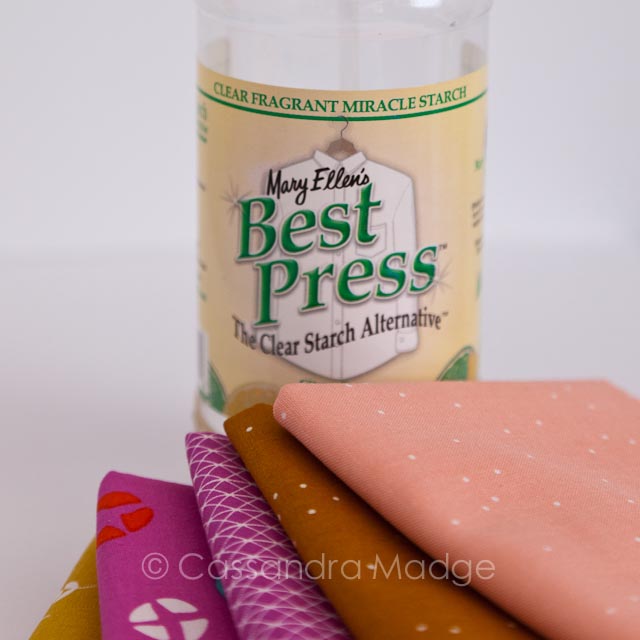
So, what’s the solution? Ditch the starch? No! Just be completely consistent in it’s application. If you are going to use starch, you have to use it from the very start, before you cut your blocks. Then the shrinkage has already happened and you can go on to use it to press stubborn seams and tame triangles to your merry heart’s content. If you use it on only selected fabrics in a block, you could have trouble with uneven block sizes and your seams might not line up.
However, there is a bright side to this – the knowledge that you can use this power for good! For example, I was piecing up some blocks this week that, due to my own laziness and “speed sewing” were not matching up. My side sections were larger than the centre sections every single time! I knew I hadn’t used starch on any of the fabrics, so I harnessed the shrinking power of starch. By laying out the side pieces only, and starching them, I helped to reduce the size difference between the sections, allowing me to easily pin and ease the blocks into submission.

Starch will always be a valuable part of my sewing and quilting kit – now I know how to use it, and keep it’s special powers under control! Please share or pin this tutorial, so that we can spread the word.

Please be aware that there may be affiliate links in this content. Your support allows me to keep creating for you!



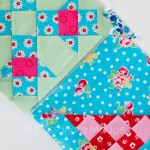
Jenny L
Well I never knew…. Thanks for this. I shall have to be more careful particularly when precision counts.
Cassandra
So glad that I could help everyone out Jenny 🙂
agnes
Well this certainly explains things! I’ve been doing a lot of small piecing and had gotten to a point of cutting slightly bigger and then starching to get my final blocks to be accurate. Now I know why! Thank you! I should try starching before cutting and see how my final blocks measure.
Cassandra
I hope that it helps you Agnes, I really felt like I’d discovered treasure when I worked it out!
Jen @ Faith and Fabric
This is a brilliant article! I’ve run into shrinking fabrics, and had no idea why. Thanks for taking the time to write this up – and your idea of shrinking fabrics when they don’t *quite* fit is great.
Cassandra
Thanks so much Jen! I really felt that it would help a lot of frustrated quilters!
Maria
It’s not the starch only. I’ve found steam to have the similar effect. Best to press and starch fabrics before cutting. Those small amounts of shrinkage do add up. Thanks for the visual.
Linda
I was working with a charm pack and a mini-charm pack. After starching everything so well, I was ready to start on my project. My 5 inch squares had turned into rectangles of 5 x 4.75″ and my mini-charms lost an eighth of an inch on one side only. I thought it was me going crazy and that I had a bad cut of charms. Interesting that it only shrunk on one side!
Cassandra
Linda, I think the difference is between the strength/spacing of the warp and weft threads. I know that Marti Michell says that the longwise grain (parallel to the selvedge) is the strongest, so therefore it may shrink less? I’m sorry that you had to find out about this the hard way. I wish more people would share this information around 🙂 Thanks so much for commenting.
Linda Strouo
When starching the entire yardage..is spraying best press enough? Or do you need to soak… never done that but heard about it…seems like alot of work and have limits to my time. Now, let me get this right…if i get the entire ysrdage starched…i can starch away yo open those seems? Thanks gor the info.
Cassandra
Hi Linda, Sorry about taking so long to get back to you. I would suspect that a thorough spray, along with pressing, should be enough to activate the starch and shrinkage factor in your yardage. However I am only reporting my findings and would encourage you to maybe run some trials yourself, depending on the fabric, iron and starch you prefer to use. And yes, my experience is that once it has been starched, further applications do not cause it to shrink any further, so you should be able to use the starch on your seams without fear. I hope this helps 🙂
Karen Alexander
I would say that it’s not the starch. But the fact that you did not pre-wash your fabrics! Just like that lovely flannel shirt you bought at Christmas that’s now a size too small after a wash and dry – all cotton fabrics shrink when washed – and more when dried. The amount varies, but yes, 3-6% is pretty common. In addition, when you work with unwashed fabrics, you are working with all manner of chemicals used in the weaving, dyeing and/or printing of the fabric that are still in the fabric. What are they? We probably don’t want to know! Wash your fabrics before you sew. That will take care of any future shrinking. It also solves the problem of bleeding as well. Don’t use starch on fabrics that are not prewashed. They already contain sizings and stiffeners. No additional starching needed. Starch is for adding stiffness to washed fabrics! Ask Marti, and I’m sure she’ll concur!
Barbara Clark
Always wondered, now I know! I pre-wash most every fabric that enters my house. Now I know why I don’t have that problem.